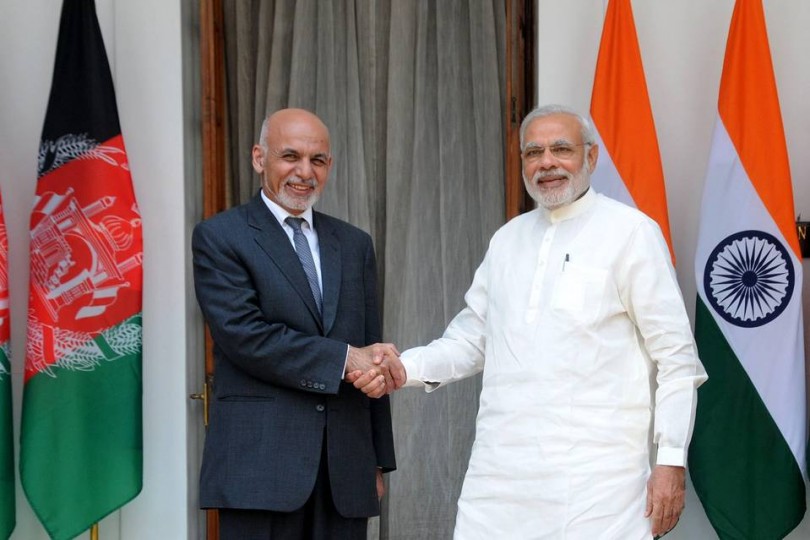Afghan President Ashraf Ghani recently visited India for the first time since assuming office in September 2014. Both Ghani and Modi emphasized on combating terrorism, stressed connectivity and shared views on enhancing security.
Both sides had also agreed to sign six pacts within next three months, which include an extradition treaty, a motor vehicle agreement and a mutual legal assistance pact. Ghani also thanked India for $2.2 billion aid into his country’s development over the past decade.
However, the visit did not seem to yield significant results for India. Neither bilateral agreements were signed nor any announcements were made related to defence or strategic cooperation, which indicates that Indian influence in Afghanistan is diminishing. Moreover, Ghani decided to visit India only after he had visited China and Pakistan.
Since Ghani assumed premiership, relations between Afghanistan and India have been strained. In February 2015, Ghani suspended a request made by Karzai that India should provide heavy arms to the Afghan military. Moreover, six Afghan army cadets arrived in Pakistan [instead of India] for training. Ghani’s India visit was to mollify the strained relation between the two nations and to attract Indian investment in Afghanistan.
Historically, India and Afghanistan have always enjoyed great relations. India was the only South Asian country to recognize the Soviet-backed Democratic Republic of Afghanistan in the 1980s. Relations between the two nations were reduced owing to the Afghan civil war in early 1990s. The civil war brought Afghan Taliban into power in 1996. India was one of the main enemies of the Afghan Taliban and consequently became one of the main supporters of the anti-Taliban Northern Alliance.
After the fall of Afghan Taliban in 2001, India resumed friendly relations with the Karzai Government. In 2005, India proposed Afghanistan’s membership in the SAARC. The relations between both nations were further strengthened by the Strategic Partnership Agreement signed in 2011.
Furthermore, India is involved in various construction projects and investing in health and education sectors as well as helping to train Afghan civil servants, diplomats, army and police. India is the 5th largest international donor to Afghanistan. The bilateral trade between both nations stood at $683 million in 2013-14.
During Karzai’s rule, Indian spy agency RAW and NDS collaborated to fund and train TTP and BLA. In 2011, the then USA under-secretary of state for political affairs, William Burns gave Indian officials a terse directive to stop sending mercenaries across the Durand Line. Former USA Secretary of Defense Chuck Hagel had also said that India financed troublemakers for Pakistan from Afghanistan.
After the departure of Karzai in 2014, the new Ghani government appears to be looking towards Pakistan and China. Relations between Pakistan and Afghanistan have improved since Ghani assumed office. Numerous visits of government and military officials of both nations were held in past few months. Both nations have decided to cooperate in security areas and to put in place effective border management. Ghani is looking towards Pakistan to bring Afghan Taliban on negotiations’ table. China has also supported Afghan peace negotiations. China is considered as one of the leading investors in the Afghan economy. It has heavily invested in infrastructure projects and mining sector in Afghanistan.
During Ghani’s recent visit, Modi expressed India’s interest in joining Afghan Pakistan Trade and Transit Agreement to allow goods to flow by land from Afghanistan to India and back via Pakistan. Pakistan could provide Indian goods land access to Afghanistan if relations between Pakistan and India improve, which is unlikely in the near future.
The Modi government has resisted every opportunity to engage Pakistan. India cancelled talks after Pakistan’s envoy to India Abdul Basit had a routine meeting with Hurriyat leaders in August 2014. In March 2015, the Indian foreign secretary visited Islamabad but the visit proved to be futile.
Moreover, if Pakistan provides land access to Indian goods to Afghanistan will India also provide land access to Pakistani goods to Bangladesh and Nepal?
On the other hand, India is about to finalize a plan to invest in Iran’s Chabahar Port. The Chabahar Port will allow India to send its goods from Chabahar to Afghanistan, Central Asia and beyond. India will offer Afghanistan to use Chabahar port in future to reduce Afghanistan’s dependence on Pakistan.
Afghanistan is considered as vital part of India’s Central Asia strategy, as the landlocked state provides access to oil and mineral-rich Central Asia. Secondly, India does not want the emergence of Afghan Taliban in Afghan politics. Thirdly, reconstruction of infrastructure in Afghanistan provides opportunities for Indian companies. Fourthly, Afghanistan itself is rich in natural resources including rare earth elements, and without stable Afghanistan it would be difficult to extract the minerals.
Afghanistan should have good relations with all countries including India. As a sovereign country, Afghanistan has every right to have trade and investment ties with India. But India should not be allowed to use Afghanistan for unleashing its proxies like TTP and BLA, which are involved in spreading terrorism in Pakistan.







